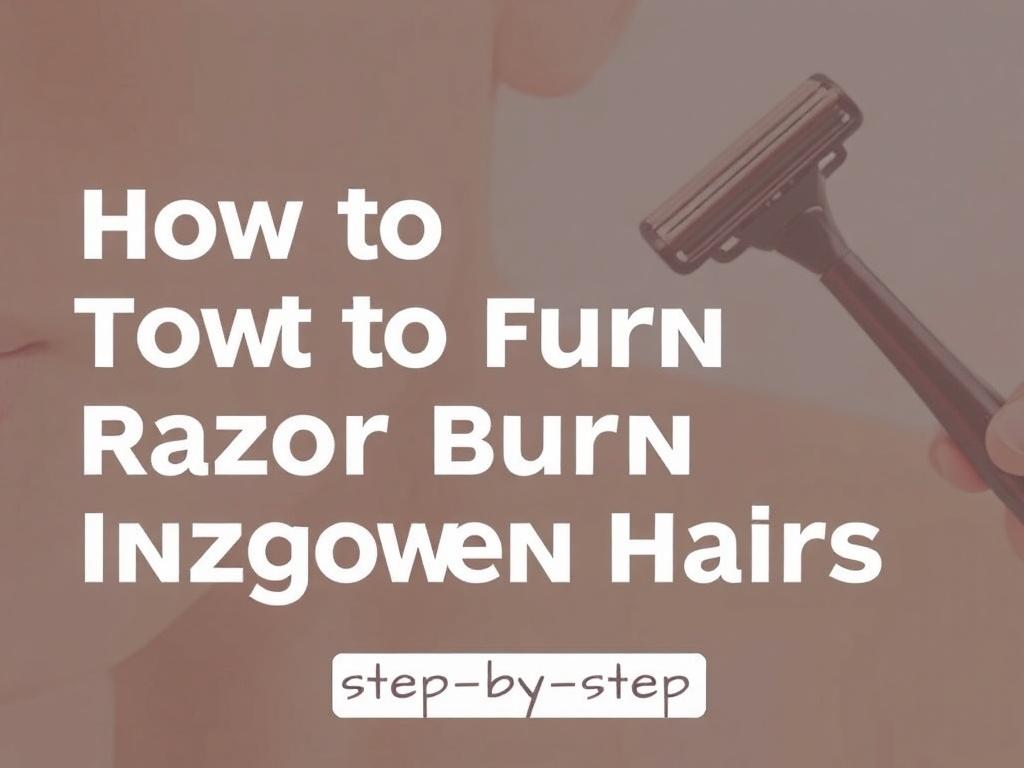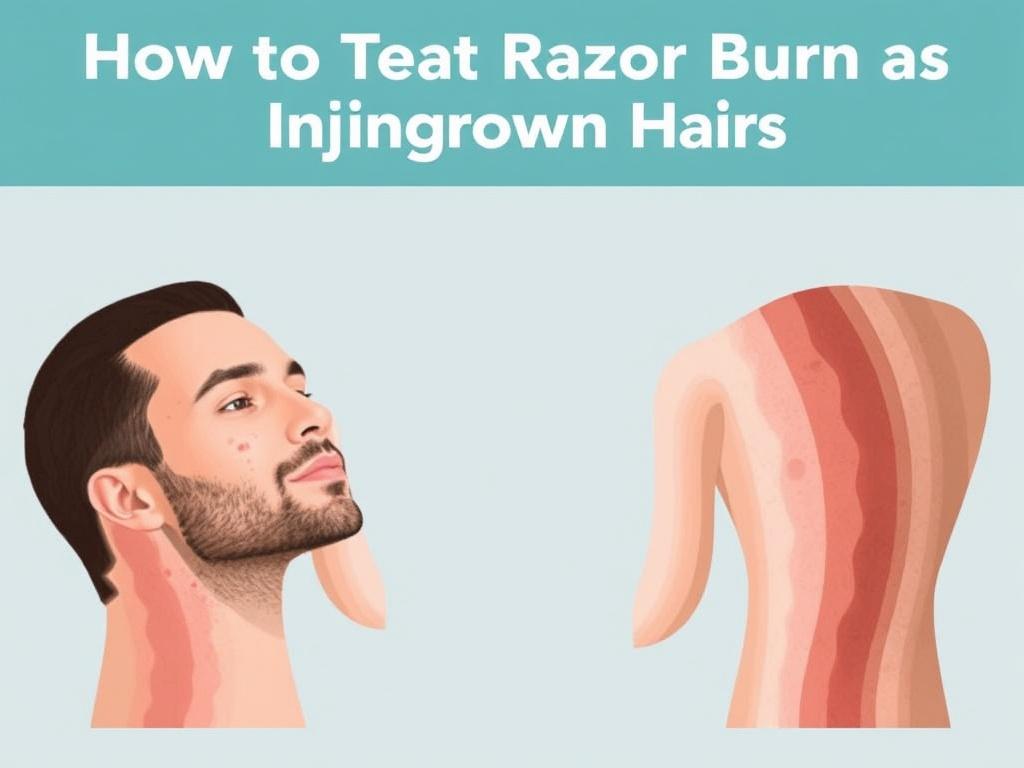Содержание статьи
- 1 Understanding Razor Burn and Ingrown Hairs
- 2 How to Treat Razor Burn and Ingrown Hairs: Step-by-Step
- 3 Prevention: How to Avoid Razor Burn and Ingrown Hairs in the Future
- 4 Home Remedies and Natural Treatments for Razor Burn and Ingrown Hairs
- 5 When to See a Doctor
- 6 A Summary Table of Razor Burn and Ingrown Hair Treatments
Shaving is a daily ritual for many, yet it often comes with unwelcome side effects like razor burn and ingrown hairs. If you’ve ever felt that itchy, irritated, or bumpy sensation after shaving, you’re not alone. Razor burn and ingrown hairs can be uncomfortable, unsightly, and sometimes even painful. But the good news? With the right knowledge and techniques, treating these common shaving woes—and preventing them—becomes much easier. In this article, we’ll dive deep into how to treat razor burn and ingrown hairs, exploring causes, prevention strategies, and effective treatments that will leave your skin feeling smooth and fresh.
Understanding Razor Burn and Ingrown Hairs
Before figuring out how to treat razor burn and ingrown hairs, it’s important to understand what they actually are and why they happen. Razor burn is a skin irritation typically caused by shaving too closely or using a dull blade. It results in redness, itching, and a burning sensation. Ingrown hairs, on the other hand, occur when shaved hairs curl back or grow sideways into the skin, causing inflammation and bumps.
The delicate skin around hair follicles reacts to these issues, often causing discomfort. Razor burn and ingrown hairs frequently appear in areas that are shaved or waxed, such as the face, legs, bikini line, and underarms. Factors like shaving technique, skin type, and even the products used can influence how prone you are to these problems.
Common Causes of Razor Burn
Razor burn results from damage to the skin during shaving. Here’s a quick overview of the key causes:
- Dull Razor Blades: Razors that are old or dull require more pressure and cause more irritation.
- Shaving Dry Skin: Shaving without water or a proper lubricant increases friction and damages skin cells.
- Shaving Against the Grain: While shaving against the hair growth can give a closer shave, it also increases the chance of irritation.
- Using Harsh Products: Some soaps or aftershaves contain ingredients that dry out or irritate the skin.
- Multiple Passes: Going over the same area repeatedly can cause micro-cuts and irritation.
What Causes Ingrown Hairs?
Ingrown hairs develop when a hair grows back into the skin instead of out of the follicle. This happens when:
- Hair is cut too short during shaving, making it easier to curl under the skin.
- The direction of hair growth leads the hair to curl beneath the surface.
- Dead skin cells clog hair follicles, trapping the hair inside.
- Improper shaving techniques cause hairs to be cut unevenly or at an angle prone to ingrowth.
- Curly or coarse hair types are more prone to ingrown hairs.
How to Treat Razor Burn and Ingrown Hairs: Step-by-Step

Treating razor burn and ingrown hairs properly involves soothing the skin, removing any trapped hairs carefully, and encouraging healing without further irritation. Let’s explore the best methods to calm your skin and get rid of those pesky bumps.
1. Immediate Care After Shaving
Right after shaving, your skin is vulnerable. Think of it as an open invitation to irritation and infection if not handled with care. Here are some steps to follow immediately after shaving:
- Rinse with Cool Water: Splashing cool water on your skin helps close pores and reduce inflammation.
- Apply a Soothing Moisturizer: Use a gentle, fragrance-free lotion or aloe vera gel to hydrate and calm the skin.
- Avoid Irritating Products: Skip alcohol-based aftershaves or harsh scrubs immediately after shaving.
- Wear Loose Clothing: Tight garments can rub against your skin and exacerbate razor burn and ingrown hairs.
2. Treating Razor Burn
If you wake up with that familiar red, itchy burn, here’s how to treat razor burn effectively at home:
| Treatment | Benefits | How to Use |
|---|---|---|
| Aloe Vera Gel | Reduces redness, soothes irritation, and hydrates skin | Apply a generous amount directly to affected areas multiple times daily |
| Cold Compress | Calms inflammation and itching | Use a cold washcloth or ice pack wrapped in a cloth, apply for 5-10 minutes |
| Hydrocortisone Cream | Relieves itching and inflammation | Use sparingly as directed, avoid prolonged use without consulting a doctor |
| Coconut Oil | Moisturizes and has antimicrobial properties | Apply a thin layer after shaving or when irritation flares up |
| Over-the-Counter Antiseptics | Prevents infection on broken or irritated skin | Use on affected area when micro-cuts or irritation is severe |
Remember, while it’s tempting to scratch or irritate razor burn, try to resist. Scratching can worsen the inflammation and even cause scarring.
3. Treating Ingrown Hairs
Dealing with ingrown hairs requires careful attention to avoid infection or scarring. Here’s a simple routine to follow:
- Exfoliate Gently: Use a mild exfoliant or a washcloth to remove dead skin cells and free trapped hairs.
- Warm Compress: Apply a warm compress to soften the skin and encourage hairs to emerge naturally.
- Use a Sterile Needle or Tweezers: If a hair is visible under the skin, you can gently lift it out. Avoid digging or picking at the skin.
- Apply Antibacterial Cream: After removing the hair, use an antibacterial ointment to reduce the risk of infection.
- Keep the Area Moisturized: Hydrated skin is less likely to develop more ingrown hairs.
Prevention: How to Avoid Razor Burn and Ingrown Hairs in the Future
While treating existing razor burn and ingrown hairs is important, prevention is even better. Adopting proper shaving habits and skincare routines will help maintain clear, smooth skin over time.
Essential Tips for Prevention
| Tip | Explanation |
|---|---|
| Use a Sharp Razor | Dull blades tug at hair and skin, leading to irritation. Replace razors frequently. |
| Shave After or During Shower | Warm water softens hair and skin, allowing for a smoother shave. |
| Use Quality Shaving Cream or Gel | Provides lubrication and protection, reducing friction and irritation. |
| Shave in the Direction of Hair Growth | Minimizes the risk of hairs curling back into the skin. |
| Avoid Multiple Passes | Try to limit shaving over the same spot to reduce irritation. |
| Exfoliate Regularly | Removes dead skin cells and prevents clogged follicles. |
| Moisturize Daily | Keeps skin supple and reduces dryness and irritation. |
| Don’t Share Razors | Reduces risk of bacterial infection that can worsen irritation. |
Alternative Hair Removal Methods
If you regularly suffer from razor burn and ingrown hairs, consider experimenting with other hair removal options:
- Electric Razors: Tend to be less irritating as they don’t cut as closely to the skin.
- Depilatory Creams: Chemical creams that dissolve hair at the skin surface—test on a small patch first to check for sensitivity.
- Waxing: Pulls hair from the root and may reduce frequency of ingrown hairs, but can be painful and cause irritation if not done properly.
- Laser Hair Removal: A longer-term solution that reduces hair growth and decreases the likelihood of razor burn and ingrown hairs.
Home Remedies and Natural Treatments for Razor Burn and Ingrown Hairs
Many people seek home remedies for gentle, natural relief. Here are some effective treatments that use ingredients you might already have:
- Aloe Vera: Known for its soothing properties, aloe vera cools irritated skin and supports healing.
- Tea Tree Oil: Has antibacterial and anti-inflammatory effects—dilute with a carrier oil before applying.
- Honey: A natural antiseptic that can soothe razor burn when applied as a thin layer.
- Oatmeal Baths: Soothing for inflamed skin, oatmeal can reduce itching and redness.
- Coconut Oil: Moisturizes and protects skin against bacteria.
Remember to patch test any home remedy on a small area first to avoid unexpected allergic reactions.
When to See a Doctor

For most people, razor burn and ingrown hairs clear up with proper care. However, if you notice severe symptoms—such as intense pain, swelling, pus-filled bumps, or if your skin appears infected—it is important to seek medical advice. Your doctor can prescribe treatments like antibiotics, topical steroids, or specialized skincare products to help heal your skin safely.
Signs You Should Consult a Healthcare Professional
- Persistent redness and swelling
- Painful bumps that worsen over time
- Signs of infection such as pus or fever
- Scarring or hyperpigmentation that concerns you
Tips for Sensitive Skin
If you have sensitive skin, annoying razor burn and ingrown hairs can become chronic issues. It’s important to select shaving products formulated for sensitive skin, avoid fragrances and alcohol, and tailor your routine to be as gentle as possible. Using hypoallergenic creams and shampoos, moisturizing thoroughly, and shaving less frequently can make a big difference.
A Summary Table of Razor Burn and Ingrown Hair Treatments

| Condition | Immediate Treatment | Prevention Tips | When to Seek Help |
|---|---|---|---|
| Razor Burn | Aloe vera gel, cold compress, hydrocortisone cream | Use sharp razors, shave with cream, shave in direction of hair growth | Severe redness, pain, or persistent inflammation |
| Ingrown Hairs | Warm compress, gentle exfoliation, removal with sterile tweezers | Exfoliate regularly, shave with sharp blades, avoid dry shaving | Infection signs, painful swellings, or no improvement after self-care |
Conclusion
Razor burn and ingrown hairs are frustrating skin issues that most of us have faced at some point. The key to managing and treating these conditions lies in gentle care, proper shaving techniques, and a consistent skincare regimen. By understanding what causes razor burn and ingrown hairs, using effective home remedies and treatments, and adopting good prevention habits, you can enjoy smoother, clearer skin without the irritation. Remember, slow and steady wins the race—rushing the shaving process or ignoring your skin’s needs will only prolong the discomfort. With patience and care, you can bring your skin back to its healthy, comfortable state and say goodbye to the itch and bumps for good!

